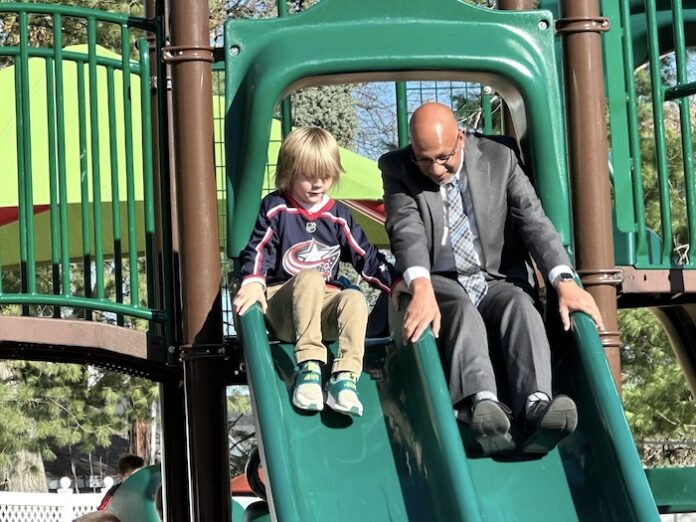Even amidst high turnover, superintendent mental health is often left out of wider conversations about student and staff wellness in K12 schools. The good news is that leaders are sharing their strategies for remaining energized and in touch with the reasons they became educators.
School board meetings, even when they go smoothly, are a source of stress for many superintendents. That’s why Superintendent Quintin Shepherd of Victoria ISD in Texas schedules elementary school visits for the morning after meeting days. He spends his time reading to kindergarteners and serving as a teaching assistant.
“A lot of superintendents fall into the mindset that there’s never time for self-care and stress management,” says Shepherd, a regular contributor to District Administration’s Leadership Institute. “‘I don’t have time’ is code for ‘I don’t care.’ It’s not OK to say you don’t care bout your wellness, whether that’s physical, emotional or spiritual wellness.”
Shepherd focuses on wellness by mentally dividing his daily commutes in half. On the way to school, he thinks about how smoothly he left his house during the first half of the commute and spends the rest of the time focused on how he wants to show up for work.

Along with cycling, running, boxing and weight training, the number 168 is also an important part of Shepherd’s self-care regimen. He recommends listing seven or eight priorities, such as work, exercise and your spiritual life, and using “168”—the number of hours in a week—to determine how much time you would like to spend on each activity every month. You can then go back through your calendar to determine how much time you actually spent on each endeavor and see if you’re satisfied with how the two figures match up.
Two important aspects of superintendent mental health at the office are delegating and staying out of the way. Superintendents don’t have to be involved in every district project. “You have to be close enough to whatever action is going that you’re still informed and still have influence but you should also realize superintendents can be too close,” Shepherd advises. “Most superintendents walk into a room thinking they’re the 180-pound executive when they are the 600-pound gorilla.”
Remembering your purpose
Superintendent Barbara Malkas’ response to the stress educators have been dealing with post-pandemic was to get teachers practicing yoga at North Adams Public Schools in Massachusetts. But it’s not only helping staff: A teacher who adopted yoga said that last school year that she did not send any students to the office because of behavioral problems.
“It’s very hard for teachers or any human being to be responsible for the social-emotional health and wellbeing of another person without first attending to themselves,” says Malkas, Massachusetts’ 2024 Superintendent of the Year and a certified yoga instructor. “By addressing self-care through mindfulness, through mindful movement and moments of presence, it allows teachers to all be there for their students and to provide that security for their students.”
For her training, Malkas chose Breathe for Change, a yoga and social-emotional learning program specifically designed for classroom educators. Over the last few years, about 45 of her teachers have also been certified. Malkas and some of her staff now offer weekly yoga classes to community members. “The discipline referrals in classes where teachers are using mindfulness and mindful movement have decreased substantially,” Malkas notes. “One teacher reported she had not had one significant office referral the entire year last year, which was revolutionary compared to the years prior.”
First-year superintendent Neil Gupta of the Oakwood School District in Ohio says he had to be intentional about embedding health and wellness into his new practice. Regularly spending time with students is at the top of his list of strategies. “It’s really easy to sit in my office and sit in meeting rooms constantly, doing a lot of work,” Gupta notes. “If we don’t block out time to walk through classrooms and cafeterias and talk with students, we forget our purpose, we forget our why.”
Listen to DA: Several superintendent spots are being filled by internal promotions
Gupta makes a point of meeting with principals at their schools (rather than at central office) and he adds time on either side of those meetings to visit classrooms and students. He has also formed a close relationship with a pair of out-of-district, out-of-state colleagues whom he can text regularly and discuss the challenges of running a school district. “They can say things to me I don’t want to hear from other people, as far as ‘Hey, Neil you’re wrong,’ ‘Hey, Neil you should’ve done more,'” Gupta notes.
Superintendents need passion projects to avoid falling into a rut. Gupta is about to launch STEM initiatives and gather community input for the district’s strategic plan. Finally, Gupta has found that expressing appreciation keeps him charged and thinking positively. He has supplied his administrators with a large set of blank greeting cards and has tasked himself and his team of 15 with sending out gratitude cards each week to staff and students.
He describes the exercise as a tangible way to count your blessings. “There’s something mentally that happens to you when you’re writing an ‘Appreciate You’ card to somebody else,” he explains. “By the time I leave the kitchen table after writing 15 cards, I’m in a better spot mentally and in how I feel about my district.”
Taking ownership of health and wellness
Former superintendent Baron Davis says the key to wellness is designing a self-care routine and blocking out time so work doesn’t intrude. But that doesn’t mean handing off your job responsibilities or waiting for the school board to set time aside for superintendent mental health. “The trap you fall into is you start assigning the responsibility of your care to other people,” declares Davis, the founder and CEO of The Noegenesis Group, an education think tank and consulting firm.
But superintendents can find an accountability buddy who can help keep them on track with their self-care routines, which can be as simple as meditating in the office for 15 to 20 minutes a day or taking short walks. When Davis was a superintendent, he kept a small putting surface in his office and continued hitting golf balls until he got six in a row into the hole. He also kept a chessboard and periodically played a piece on both sides.
Leaders should try to devote 10% of each month—or 72 hours—to self-care (not including sleep). Book golf outings regularly, for instance, and use your vacation time if you love to travel. It boils down to prioritizing activities that bring leaders joy and allow them to shift their focus from day-to-day responsibilities and stressors that accompany the work.
“Stay connected to colleagues, lean on people—vulnerability is not a bad thing,” Davis concludes. “If you’re not practicing self-care, you’re actively practicing self-harm.”










